 |
 |
 |
 Editorials | Environmental | June 2006 Editorials | Environmental | June 2006  
A Call to Revitalize Once-Lush Estuary
 Sandra Dibble - Union-Tribune Sandra Dibble - Union-Tribune

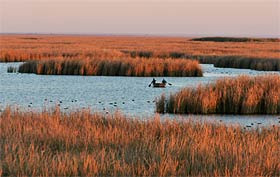
| | A haven for endangered species, the Cienega de Santa Clara is sustained by agricultural runoff from Arizona. The ciénega consists of shallow canals and broad pools surrounded by cattails. (Photos: Peggy Peattie/Union-Tribune) | 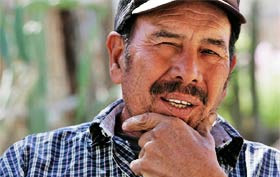
| | Germán Muñoz wants to restore the Rio Hardy, a tributary of the Colorado River. Muñoz has lived in the delta for most of his life and remembers when the river teemed with migratory ducks. | 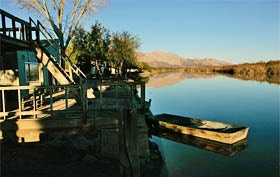
| | The chance to fish and hunt once brought an abundance of U.S. visitors to the Rio Hardy. But many stopped coming when the river dried up, and their old camps are mostly empty. Local residents built a check-dam to bring the water level back up. | 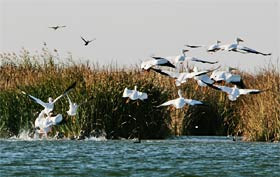
| | American white pelicans feed in the Cienega de Santa Clara. An important stop on the Pacific Flyway for migratory birds, the ciénega offers potential for ecotourism. | 
| | Diane LaRue, of Nova Scotia, who is helping to set up a nursery at Campo Mosqueda, germinated cottonwoods that will be transplanted to help restore the delta, which contains some of the largest stands of native trees on the Colorado River. |
It has been ravaged by loss of water, but environmentalists say it's not too late for Mexico's Colorado River Delta.

Rio Hardy, Mexico – There were once so many mallards, they seemed like thick, dark clouds against the sky. So loud, they reminded Germán Muñoz of an entire stadium, wild with applause, when their webbed feet struck the water's surface.

But the migratory ducks stopped coming years ago when the wetlands dried up and salt cedar shrubs took over. Muñoz longs for their return, and at 59, the hunting guide is working to bring them back, cutting away the salt cedar, watching water levels and planting fragrant mesquite trees that once graced this land.

Here and elsewhere on the Colorado River Delta, once-lush landscapes now survive largely on runoff, leaks and surpluses. Today, even those flows are threatened as users upstream vie for every drop.

As it crosses nine states in two countries, the 1,450-mile river is a lifeline that provides drinking water to 25 million people and irrigation for 3.5 million acres of agricultural land; but few remember the stands of cottonwoods and willow, the cattail marshes filled with wildlife that still persist at the river's ravaged and resilient mouth.

Claiming the delta as a shared legacy of the United States and Mexico, an eclectic group of scholars, environmentalists, government officials, volunteers and local residents are searching for ways to keep it alive.

The solution is simple, they say: Just add water. It wouldn't take much – just the willingness of users upstream to consider the delta as they fill their pools, water their lawns and irrigate their fields with flows from the Colorado River.

“There are huge opportunities for recuperation; with just a little care, we can do a lot,” said Osvel Hinojosa, a wildlife ecologist with Mexico's oldest and largest environmental group, Pronatura. “If we don't do anything, it's going to disappear, bit by bit.”

For all the destruction, there is still much to hold on to in the delta: It remains the largest desert estuary in North America, an area about 175 miles east of San Diego that still supports 300,000 wintering water birds, and provides a critical habitat for endangered species such as the Yuma clapper rail and the yellow-billed cuckoo. Its riparian corridor still contains some of the largest stands of native trees on the Colorado River.

The delta's surviving natural areas continue to funnel fresh water to the Gulf of California, sustaining shrimp and fish populations, including the endangered totoaba fish. There are also human survivors: Some 200 Cucapah Indians, descendants of the area's original inhabitants, still live here, in the impoverished community of El Mayor.

Still, as disputes among users simmer, their resolution will have immediate implications in the delta. Mexico is complaining about a California conservation plan to line the All-American Canal in Imperial County and thereby increase San Diego County's supply of Colorado River water, saying farmers south of the border and the environment depend on seepage of river water from the canal.

Faced with institutional barriers and a lack of funding, advocates of the delta's rehabilitation are sustained by some hopeful signs: a move in Mexico's federal government to designate an 82,000-acre area of the delta as a restoration zone; support from the U.S. Fish and Wildlife Service for a 28-acre pilot project in the riparian corridor; and willingness by Arizona water managers to consider the effects of their policies south of the border.

“Restoration is achievable in the delta, because most of the fresh water or aquatic plants are fast-growing,” said Exequiel Ezcurra, director of scientific research at the San Diego Museum of Natural History, and former head of Mexico's National Institute of Ecology.

Managing the river

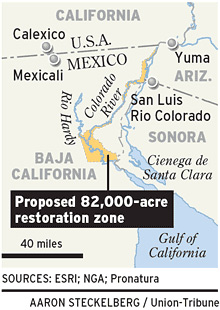 The naturalist Aldo Leopold, who paddled through the delta in 1922, wrote of deep emerald waters rich with fish and fowl, of feasting on goose roasted over a mesquite fire: “The river was nowhere and everywhere. For he could not decide which of a hundred green lagoons was the most pleasant and least speedy path to the Gulf.” The naturalist Aldo Leopold, who paddled through the delta in 1922, wrote of deep emerald waters rich with fish and fowl, of feasting on goose roasted over a mesquite fire: “The river was nowhere and everywhere. For he could not decide which of a hundred green lagoons was the most pleasant and least speedy path to the Gulf.”

Today, getting to the remaining natural areas involves traveling past wheat and cotton fields of the Mexicali Valley, down straight roads lined with irrigation canals, and over bridges looking down on dried-out and weed-choked streambeds of the Colorado River.

The delta once covered 2 million acres, from the Coachella Valley to the Gulf of California, but now it is one-tenth that size. Most of it is in Mexico, spanning the states of Sonora and Baja California.

The year Leopold traveled the delta, seven U.S. states signed the Colorado River Compact dividing the river's flow; 22 years later, the United States and Mexico signed a treaty that gave Mexico 1.5 million acre-feet a year, most of which supplies cities and farms along the border. But nobody thought to set aside water for environmental ends, and as more dams were built upstream, the delta gradually lost its water supply.

Through the early 1960s, “It was a paradise, there were so many species in the river: totoaba, turtles, shrimp, and a wide range of fish,” said Muñoz, who owned a fishing camp on the Rio Hardy, a tributary of the Colorado River. “Anything that you'd find in the Gulf came up.”

Then, for two decades, as more U.S. reservoirs were being filled, there was barely any flow, Muñoz said. In the 1980s, a combination of unusually heavy snowmelt and warm rains led to huge releases from the dams that proved devastating to Muñoz and his neighbors, leaving their properties underwater and covered with silt.

But the floods were also an unexpected boon to the natural environment. As the water flowed to the delta, the biggest surprise was the return of willows and cottonwoods. Written off by environmentalists as a lost cause, the unforeseen blossoming revived interest in its preservation.

“Right now, we're teetering on whether we're going to hold on to that or lose it again,” said Jennifer Pitt, a scientist with the Colorado-based group Environmental Defense, which has been involved in the delta since the 1990s.

In December 2000, the U.S. and Mexican governments jointly recognized the delta's importance, with the signing of an agreement known as Minute 306. The document provides a framework for cooperation, but progress has been slow.

Environmentalists took a key step last year, identifying 15 conservation areas in the delta in a report published by Environmental Defense, the Tucson-based Sonoran Institute and other groups from both sides of the border.

Their list includes nearly 5,000 acres of artificial ponds created by the Cerro Prieto Geothermal Plant in Baja California, a habitat for the desert pupfish, and more than 4,300 acres along the Rio Hardy, a 25-mile tributary now fed by saline agricultural waste water. The Colorado River Riparian Corridor, a ribbon of 51,000 acres along the river's main stem that includes a stretch north of the corridor, includes the largest stands of cottonwoods and willows in the lower Colorado River basin.

“The idea is not to restore the delta as it was 100 years ago,” said Francisco Zamora, director of the Sonoran Institute's Colorado River Delta Program. “It's just to work to protect and maintain these 15 conservation priority areas.”

Environmentalists say the long-term solution means guaranteeing at least 50,000 acre-feet annually to keep the river's main stem wet in between larger flows that allow willows and cottonwoods to persist in the floodplains.

Finding the water, they say, will take a combination of approaches – from purchasing the water from local farmers to diverting more treated water from sewage plants to channeling more waste flows from agriculture.

One hopeful sign for the delta is the increased commitment shown by Mexico's federal government.

Mexico's National Institute of Ecology in Mexico City, the environmental research arm of the federal government, is working with environmental groups to promote water markets as the way to bring more water to the delta. Mexico passed a law in 2004 that recognizes the ecological value of water – but regulations must be written before water markets can come to pass.

INE and environmentalists are also pushing for the establishment of a riparian conservation zone in the delta, but the final decision rests with the Mexican environmental ministry, Semarnat.

While no government funds are allocated, it would encourage potential donors.

“There are foundations that are interested, but they are unsure of what will happen with their donations, and want a legal structure to protect them,” said Eduardo Peters Recagno, director of ecosystem conservation for INE.

Saving a ciénega

The Cienega de Santa Clara rises like a mirage from the dusty, desolate landscape of the southern delta, linked by dirt road to a small, impoverished communal farming community, the Ejido Luis Encino Johnson.

The brackish water is too salty for use in agriculture, but it supports what has become the most important marsh wetland in the Sonoran desert, and a crucial stop on the Pacific flyway for migratory birds.

To its supporters, the ciénega is proof of nature's resilience, and a prime example of threats facing the delta today as upstream users demand more water.

The sprawling wetland was created when agricultural runoff from the Wellton-Mohawk Irrigation District outside Yuma began draining into Mexico in the 1970s. Today, the flow is close to 100,000 acre-feet per year, and the ciénega is more than 12,000 acres of shallow canals and broad pools surrounded by cattails.

The wetland has been under continuous threat as U.S. water managers have kept an eye on the flow to the ciénega. A $222 million desalination facility, the Yuma Desalting Plant, was opened in 1992 by the U.S. Bureau of Reclamation to treat the water and reuse it in the United States, but costs were prohibitive and the plant has been shuttered since 1993. But now the math is changing: faced with droughts and growing demand, the bureau is preparing a test run next year.

“Our concern is, you run the plant, you kill the ciénega,” said Michael Cohen, a senior associate at the Oakland-based Pacific Institute who has studied the delta's water flows.

Environmentalists and water managers appeared headed for litigation, but the director of the Central Arizona Project thought there might be a way to compromise. “It's water lost by the U.S.,” said Sid Wilson, whose agency manages Arizona's Colorado River allocation. “But the ciénega has value and I'd hate to see it destroyed.”

Wilson gathered environmentalists and the U.S. Bureau of Reclamation to look at alternatives. They came up with a solution that envisions partial operation of the plant, but also sending poor quality groundwater from Yuma to the ciénega, and in times of extreme drought, temporary fallowing farmland basin-wide, “so no individual is harmed out of proportion,” Wilson said.

If the arrangement works, Wilson said, “we could have water management interests and environmental interests all pulling on the same oar.”

Pieces of history

Once a tributary of the Colorado River, the Rio Hardy is now a narrow channel fed by runoff from the fields of the Mexicali Valley. Rising from its shores are ghostly remnants of the past – pieces of a dock, an old trailer – when U.S. visitors came to hunt and water ski and relax in their vacation houses.

“I still love it, but with a lot of sadness,” said Germán Muñoz, watching a lone pair of ducks bobbing on the water's glassy surface.

Slowly, Muñoz and his neighbors have been working to turn things around. Eight years ago, when there was barely any flow on the Rio Hardy, Muñoz and other local residents built a dike to raise the river's level, and it became navigable once more.

If the ciénega came back, so can the Rio Hardy, they say. With time, the area could become a wildlife corridor once more.

Today there are 170 young mesquites amid the crumbling trailers and shuttered houses on Muñoz's property, and he and his wife water them by hand. Muñoz sounds discouraged sometimes: He knows it can't be like before, the money isn't there for restoration, and he would move away if he could.

But one recent Saturday morning, as a high-pitched chirp sounded, his face relaxed into a smile. “There are these really small birds, chanates,” he remembered. “And their music is so beautiful, when they're all singing together, it's like listening to an orchestra.”

Sandra Dibble: (619) 293-1716; sandra.dibble@uniontrib.com | 
 | |
 |



